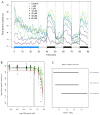Exploring Neurobehaviour in Zebrafish Embryos as a Screening Model for Addictiveness of Substances
- PMID: 34678946
- PMCID: PMC8539716
- DOI: 10.3390/toxics9100250
Exploring Neurobehaviour in Zebrafish Embryos as a Screening Model for Addictiveness of Substances
Abstract
Tobacco use is the leading cause of preventable death worldwide and is highly addictive. Nicotine is the main addictive compound in tobacco, but less is known about other components and additives that may contribute to tobacco addiction. The zebrafish embryo (ZFE) has been shown to be a good model to study the toxic effects of chemicals on the neurological system and thus may be a promising model to study behavioral markers of nicotine effects, which may be predictive for addictiveness. We aimed to develop a testing protocol to study nicotine tolerance in ZFE using a locomotion test with light-dark transitions as behavioral trigger. Behavioral experiments were conducted using three exposure paradigms: (1) Acute exposure to determine nicotine's effect and potency. (2) Pre-treatment with nicotine dose range followed by a single dose of nicotine, to determine which pre-treatment dose is sufficient to affect the potency of acute nicotine. (3) Pre-treatment with a single dose combined with acute exposure to a dose range to confirm the hypothesized decreased potency of the acute nicotine exposure. These exposure paradigms showed that (1) acute nicotine exposure decreased ZFE activity in response to dark conditions in a dose-dependent fashion; (2) pre-treatment with increasing concentrations dose-dependently reversed the effect of acute nicotine exposure; and (3) a fixed pre-treatment dose of nicotine induced a decreased potency of the acute nicotine exposure. This effect supported the induction of tolerance to nicotine by the pre-treatment, likely through neuroadaptation. The interpretation of these effects, particularly in view of prediction of dependence and addictiveness, and suitability of the ZFE model to test for such effects of other compounds than nicotine, are discussed.
Keywords: locomotion behavior; neuroadaptation; nicotine; nicotinic acetylcholine receptor; zebrafish embryo.
Conflict of interest statement
The authors declare no conflict of interest. The funders had no role in the design of the study, in the collection, analyses, or interpretation of data, in the writing of the manuscript, or in the decision to publish the results.
Figures





References
-
- U.S. Department of Health and Human Services . The Health Consequences of Smoking: 50 Years of Progress. A Report of the Surgeon General. U.S. Department of Health and Human Services, Centers for Disease Control and Prevention, National Center for Chronic Disease Prevention and Health Promotion, Office on Smoking and Health; Atlanta, GA, USA: 2014.
-
- World Health Organization (WHO) WHO Report on the Global Tobacco Epidemic: Addressing New and Emerging Products. World Health Organization (WHO); Geneva, Switzerland: 2021.
LinkOut - more resources
Full Text Sources

